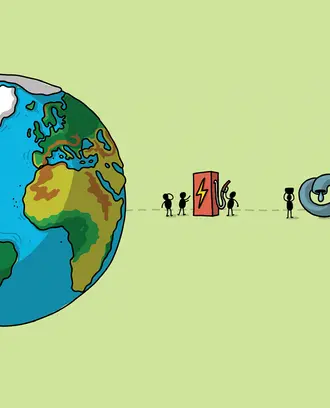Credit: Cienpies Design / Shutterstock
Ever since the European Investment Bank issued the first green bond in 2007, more and more investors are choosing to finance projects that support sustainability and mitigate the effects of climate change. And as interest in ESG continues to build, there is ample opportunity for institutional capital investors to move the needle on sustainability, according to experts at the annual MIT Sustainability Summit, which explored how companies can use metrics and standards to define and measure sustainability.
In fact, sustainable debt — bonds and loans raised with environmental and social purposes in mind — rose 29% to $732.1 billion in 2020, the greatest issuance amount ever in a single year, according to energy research group BloombergNEF. In addition, a report from Moody’s Investor Services showed global flows to environmental, social, and corporate governance concerns increased to $80.5 billion in the third quarter of 2020, up 14% from the previous quarter.
“I don’t think we would have seen those dynamics even five years ago,” said Hugh Lawson, Global Head of ESG Impact and Institutional Client Strategy at Goldman Sachs Asset Management.
As interest has increased, however, so has the discussion over accountability and whether organizations are “greenwashing” versus truly effecting environmental change. Lawson said that if a business claims to be green, “you do need a way to verify what they're saying is true.”
“The scrutiny on making sure that the rhetoric and the reality match up is important and is having a positive effect,” said Lawson, who sat on a panel moderated by a professor of applied economics and co-faculty director of the MIT Sloan Sustainability Initiative.
During the session, panelists discussed how far the industry has come in establishing guidelines and performance standards, but also acknowledged the many challenges that still remain, including how to spur change within big financial institutions.
Inside the banking sector, change takes time
Even though plenty of financial institutions agree that it’s time to tackle the climate crisis, it isn’t easy implementing change at large financial institutions that have “spent decades establishing rules of order,” said Michael Eckhart, former global head of environmental finance for Citigroup and currently an adjunct professor of international and public affairs at Columbia University.
“The greatest challenge to addressing climate change is institutional inertia that can take 25 years to change,” Eckhart said. “You can't just order somebody to consider environment, social, and governance and expect them to carry it out perfectly every time.”
By Eckhart’s estimate, only 2% of all bond issuance is green, which he said points to a dire need to hone in on the remaining 98%. (The International Finance Corp. put the former figure at 3% for 2019.)
Responding to a question from the audience on how banks might go beyond promoting sustainable new investment to “stop the bad investments,” Eckhart wondered whether all bonds should be required to disclose how funds will be used, not just green bonds.
“Why aren't we going after the flow of capital into things or purposes that are causing climate change?” he said. “We're still funding the climate change-causing activities of industry, transportation, agriculture, and so forth. If we're not moving capital for sustainable purposes, we're not going to have a sustainable society.”
Establishing sustainable investing guidelines
On a more positive note, guidelines developed by the IFC, which lends to companies in developing countries, are being readily adopted by companies and financial institutions worldwide that want to measure and evaluate the effectiveness of their sustainability projects.
There are 116 financial institutions in 37 countries that use IFC’s performance standards, according to Stephanie von Friedeburg, IFC’s senior vice president of operations.
“Standardization of definitions is key,” said von Friedeburg. For example, IFC’s Equator Principles assess and manage environmental and social risk and provide standards for due diligence. And the IFC’s Anticipated Impact Measurement and Monitoring (AIMM) system assesses a project’s outcomes, its effect on market creation, and the ways it impacts project beneficiaries such as employees, customers, and suppliers.
“You can do good and you can do well at the same time,” von Friedeburg said. “Decide what impact you want to have, tell us how you're going to measure that impact, measure it, get an independent verification of what you're measuring — and then make money on the way out.”
The IFC is also “playing very substantively” in SDG lending, which refers to the Sustainable Development Goals adopted by the United Nations covering areas such as poverty, the environment, and education. A company may receive a lower interest rate from the IFC if they hit one or more of those sustainability milestones.
“I think we’re moving in the direction of seeing a pricing differential” between companies that are green and those that are not, she said.
The way forward: technology, millennials, and women
Banks are pledging to put investment capital to work. Goldman Sachs, for example, is allocating $750 billion toward sustainable finance by 2030 and is a third of the way to reaching its goal, Lawson said. Citigroup, meanwhile, committed $1 trillion to sustainable finance by 2030.
Related Articles
Von Friedeburg said now would be a good time for financial institutions to step up and invest in renewable technologies in emerging markets. For example, while solar was expensive in the beginning, “the cost curves have come down so dramatically that you really can drive solar and wind in Africa,” she said.
Battery storage is another example of technology that could help change the game if there were more investment. While battery storage technology is “too expensive for the emerging markets today,” if the developed world begins to invest, “then we'll see the cost curves come down.” Green hydrogen and “potentially” nuclear are additional “technologies out there that we haven’t fully utilized yet,” she said.
Von Friedeburg said she believes millennials and Generation Z will continue to spur growth and interest in sustainable investing. As these asset owners move into the market, “I think that they will force asset allocators to make different decisions,” she said. “I think we won't get far enough until we have enough of those millennials and more women in the workforce, because women tend to push for impact as well.”



